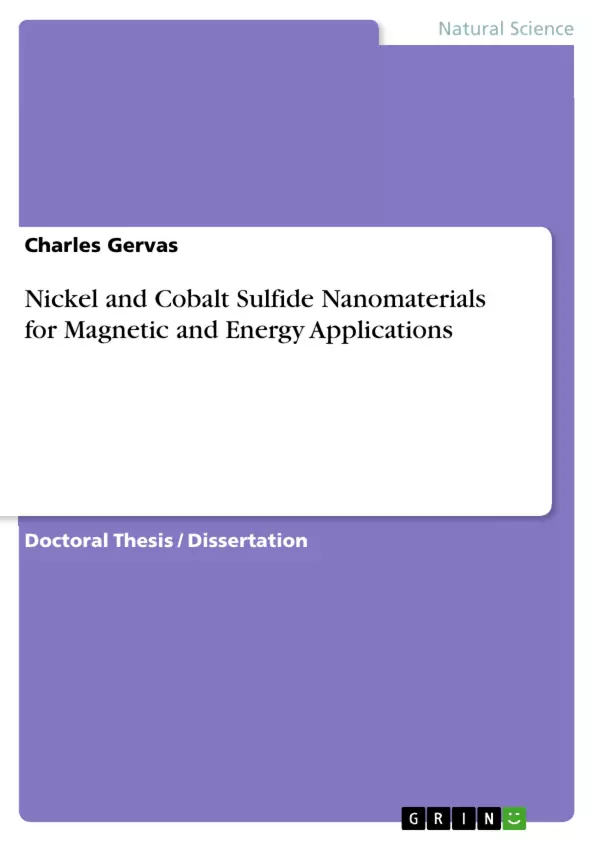
Nickel and Cobalt Sulfide Nanomaterials for Magnetic and Energy Applications
Doktorarbeit / Dissertation, 2022
182 Seiten
Leseprobe
Inhaltsverzeichnis (Table of Contents)
- CHAPTER ONE: INTRODUCTION AND LITERATURE REVIEW
- 1.1. General introduction
- 1.2. Literature Review
- 1.2.1. Nickel Sulfide (NixSy) Nanoparticles and Thin Films
- 1.2.2. Cobalt Sulfide (CoxSy) nanoparticles and thin films
- 1.2.3. Ternary Nanomaterials with Thiospinel Structure
- 1.2.4. Magnetic properties
- 1.2.5. Energy Applications
- 1.3. Statement of the research problem
- 1.4. Scope of the work
- 1.5. Aim and objectives of the work
- 1.6. Thesis layout
- 1.7. References
- CHAPTER TWO : SYNTHESIS OF RARE PURE PHASE Ni3S4 AND Ni3S2 NANOPARTICLES IN DIFFERENT PRIMARY AMINE COORDINATING SOLVENTS
- 2.1 Introduction
- 2.2 Experimental details
- 2.2.1. Materials
- 2.2.2. Synthesis of ligands
- 2.2.3. Synthesis of complexes
- 2.2.4. Synthesis of NiS nanoparticles
- 2.2.5. Characterization techniques
- 2.3. Results and discussion
- 2.3.1. Characterization of the ligands and complexes
- 2.3.2. Single-crystal X-ray structures for complexes (1) and (3)
- 2.3.3. Nickel sulfide nanoparticles
- 2.4. Conclusion
- 2.5. References
- CHAPTER THREE: HETEROCYCLIC DITHIOCARBAMATO-NICKEL(II) COMPLEXES SINGLE MOLECULAR PRECURSORS FOR NICKEL SULFIDE THIN FILMS
- 3.1. Introduction
- 3.2. Experimental details
- 3.2.1. Materials and methods
- 3.2.2. Synthesis of ligands and nickel complexes
- 3.2.3. Aerosol Assisted Chemical Vapour Deposition (AACVD) of nickel sulfide thin films
- 3.2.4. Characterization techniques
- 3.3. Results and discussion
- 3.3.1. Synthesis of single source precursors
- 3.3.2. Nickel sulfide thin films
- 3.3.3. SEM, EDX and Elemental Mapping analyses
- 3.3.4. Powder X-ray diffraction studies
- 3.3.5. Optical absorbance analysis
- 3.4. Conclusion
- 3.5. References
- CHAPTER FOUR : FACILE SYNTHESIS OF BIFUNCTIONAL CoxSy NANOPLATES FOR EFFICIENT H2/O2 EVOLUTION AND SUPERCAPACITANCE
- 4.1. Introduction
- 4.2. Experimental details
- 4.2.1. Materials
- 4.2.2. Synthesis of ligand and cobalt complex
- 4.2.3. Synthesis of CoxSy nanoparticles
- 4.2.4. Characterization techniques
- 4.3. Results and discussion
- 4.3.1 Cobalt complex and thermogravimetric analyses
- 4.3.2 Single crystal X-ray crystallography structure for complex (4)
- 4.3.3. Phase Purity and morphology analyses
- 4.3.5. OER/HER electrocatalyst studies
- 4.3.6. Supercapacitor performances studies
- 4.4. Conclusion
- 4.5. References
- CHAPTER FIVE: EFFECT OF CATIONIC DISORDER ON THE ENERGY GENERATION AND ENERGY STORAGE APPLICATIONS OF NixCO3-xS4 THIOSPINEL
- 5.1. Introduction
- 5.2. Experimental details
- 5.2.1. Materials
- 5.2.2. Synthesis of ligands and metal (Ni, Co) complexes
- 5.2.3. Preparation of NiCo2S4 nanosheets
- 5.2.4. Characterization techniques
- 5.3. Results and discussion
- 5.3.1. Synthesis of ligand and metal (Co, Ni) complexes and thermogravimetric analyses
- 5.3.2. Phase purity, christallinity and morphology analyses
- 5.3.3. XPS Measurements for the ternary samples (NiCoS-1 and NiCoS-2)
- 5.3.4. Electrocatalytic energy generation for the ternary samples (NiCoS-1 and NiCoS-2)
- 5.3.5. Electrochemical energy storage for the ternary samples (NiCoS-1 and NiCoS-2)
- 5.4. Conclusions
- 5.5. References
- CHAPTER SIX: SUMMARY OF WORK AND FUTURE OUTLOOK
- 6.1. Summary and Conclusion
- 6.2. Future Work
Zielsetzung und Themenschwerpunkte (Objectives and Key Themes)
The research focused on investigating the use of heterocyclic dithiocarbamate complexes of Ni and Co as single source molecular precursors (SSP) for the fabrication of the corresponding metal sulfide nanoparticles and thin films for application in magnetism and energy.
- The main objective was to investigate the use of various heterocyclic dithiocarbamate complexes of Ni and Co as single source molecular precursors (SSP) for the fabrication of the corresponding metal sulfide nanoparticles and thin films.
- The work focused on the synthesis, characterization, and evaluation of the chemical and physical properties of different Ni and Co complexes.
- The study examined the fabrication of various phases of binary and ternary Ni-S and Co-S systems.
- The work investigated the effects of various reaction parameters such as temperature, time, capping agent, and complex type on the morphology and phase purity of the fabricated nanomaterials and thin films.
- The study assessed the performance of the fabricated nanomaterials in a range of energy applications, including hydrogen evolution, oxygen evolution, and supercapacitance.
Zusammenfassung der Kapitel (Chapter Summaries)
Chapter 1 introduces the reader to the concepts of nanomaterials and their technological importance. It includes a comprehensive review of the relevant literature related to transition metal sulfides (TMS), particularly nickel sulfide (NixSy) and cobalt sulfide (CoxSy) systems. The chapter also highlights the significance of single-source precursor (SSP) methods for fabricating these nanomaterials and explores the challenges and opportunities related to the energy crisis. The chapter concludes by outlining the research problem, scope, aims, and objectives of the study.
Chapter 2 focuses on the synthesis and characterization of nickel sulfide (NixSy) nanoparticles. The chapter details the synthesis of three heterocyclic dithiocarbamate complexes of nickel, namely bis(piperidinyldithiocarbamato)nickel(II) (1), bis(tetrahydroquinolinyldithiocarbamato)nickel(II) (2), and bis(N'-ethyl-N�piperazinylcarbodithioato-S,S')-Nickel(II) (3), which served as single-source precursors for the fabrication of the corresponding NixSy nanoparticles. The chapter then investigates the effect of various reaction parameters such as temperature, type of capping agent, and the nature of the complex on the morphology, phase purity, and particle size of the NixSy nanoparticles. The chapter further explores the magnetic properties of the synthesized NixSy nanoparticles.
Chapter 3 explores the use of the three heterocyclic dithiocarbamato-nickel(II) complexes (1-3) for the deposition of nickel sulfide thin films via the aerosol-assisted chemical vapour deposition (AACVD) technique. The chapter details the fabrication of NiS thin films with different morphologies by varying the deposition temperature. The chapter also presents a comprehensive analysis of the thin films, using various characterization techniques, including SEM, EDX, powder X-ray diffraction, and UV-Vis spectroscopy. The chapter provides insights into the mechanism of morphological evolution of the NiS thin films.
Chapter 4 reports the synthesis, characterization, and evaluation of a novel cobalt(III) complex, [tris(morpholinodithiocarbamato)cobalt(III)] (4), as a single-source precursor for the preparation of cobalt sulfide nanoplates. The chapter examines the effect of temperature on the morphology and phase purity of the synthesized CoxSy nanoparticles. The chapter further explores the electrochemical and electrocatalytic activities of the prepared cobalt sulfide nanoplates for hydrogen evolution and oxygen evolution reactions and their performance in supercapacitance applications. The chapter highlights the superior performance of the cobalt sulfide nanoplates as bifunctional materials for energy applications.
Chapter 5 examines the effect of cationic disorder in Ni x Co 3−x S 4 thiospinel nanoparticles on their energy generation and storage applications. The chapter focuses on the synthesis of Co or Ni-rich NixCo3-xS4 nanosheets using the corresponding metal complexes of ethyl piperazino-dithiocarbamate as molecular precursors. The study investigates the electrocatalytic performance of the Ni-rich and Co-rich nanosheets in oxygen evolution reaction (OER) and hydrogen evolution reaction (HER). The chapter further explores the supercapacitance performance of the NixCo3-xS4 nanosheets and highlights the superior energy generating and storage efficiency of the Ni-rich NixCo3-xS4 sample.
Schlüsselwörter (Keywords)
This work explores the synthesis, characterization, and application of Ni and Co sulfide nanomaterials, primarily for magnetic and energy-related applications. This includes investigating the use of heterocyclic dithiocarbamate complexes as single-source precursors for the fabrication of these nanomaterials. The key themes include the control of phase purity and morphology, the influence of reaction parameters, and the evaluation of the nanomaterials for energy generation through hydrogen and oxygen evolution reactions, as well as energy storage in supercapacitor applications. Important keywords include: single source precursors, dithiocarbamates, nickel sulfide, cobalt sulfide, thiospinel, energy generation, energy storage, supercapacitor, electrocatalysis, hydrogen evolution reaction, oxygen evolution reaction, magnetic properties, and cationic disorder.
Details
- Titel
- Nickel and Cobalt Sulfide Nanomaterials for Magnetic and Energy Applications
- Veranstaltung
- CHEMISTRY
- Autor
- Charles Gervas (Autor:in)
- Erscheinungsjahr
- 2022
- Seiten
- 182
- Katalognummer
- V1194519
- ISBN (eBook)
- 9783346639974
- ISBN (Buch)
- 9783346639981
- Sprache
- Englisch
- Schlagworte
- Energy Materials Synthesis Renewable
- Produktsicherheit
- GRIN Publishing GmbH
- Preis (Ebook)
- US$ 42,99
- Preis (Book)
- US$ 55,99
- Arbeit zitieren
- Charles Gervas (Autor:in), 2022, Nickel and Cobalt Sulfide Nanomaterials for Magnetic and Energy Applications, München, Page::Imprint:: GRINVerlagOHG, https://www.diplomarbeiten24.de/document/1194519
- Autor werden
- Ihre Optionen
- Vertriebskanäle
- Premium Services
- Autorenprofil
- Textarten und Formate
- Services für Verlage, Hochschulen, Unternehmen

- © GRIN Publishing GmbH.
- Alle Inhalte urheberrechtlich geschützt. Kopieren und verbreiten untersagt.
- info@grin.com
- AGB
- Open Publishing
Der GRIN Verlag hat sich seit 1998 auf die Veröffentlichung akademischer eBooks und Bücher spezialisiert. Der GRIN Verlag steht damit als erstes Unternehmen für User Generated Quality Content. Die Verlagsseiten GRIN.com, Hausarbeiten.de und Diplomarbeiten24 bieten für Hochschullehrer, Absolventen und Studenten die ideale Plattform, wissenschaftliche Texte wie Hausarbeiten, Referate, Bachelorarbeiten, Masterarbeiten, Diplomarbeiten, Dissertationen und wissenschaftliche Aufsätze einem breiten Publikum zu präsentieren.
Kostenfreie Veröffentlichung: Hausarbeit, Bachelorarbeit, Diplomarbeit, Dissertation, Masterarbeit, Interpretation oder Referat jetzt veröffentlichen!
- GRIN Verlag GmbH
-
- Nymphenburger Str. 86
- 80636
- Munich, Deutschland
- +49 89-550559-0
- +49 89-550559-10
- info@grin.com
-









